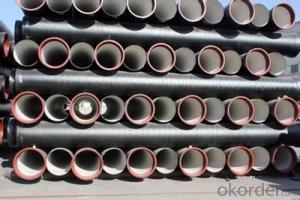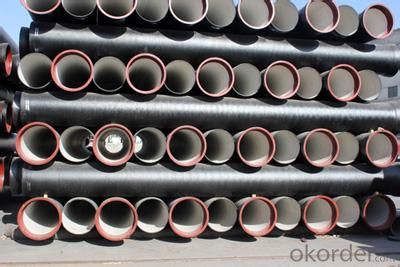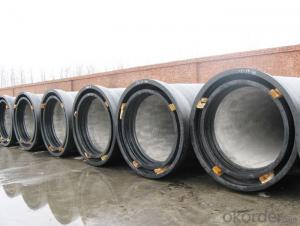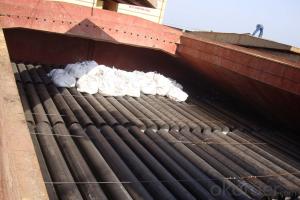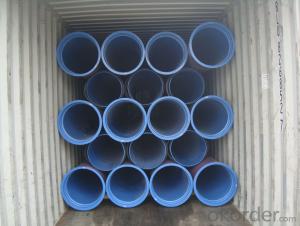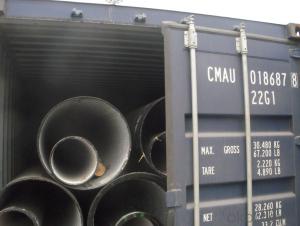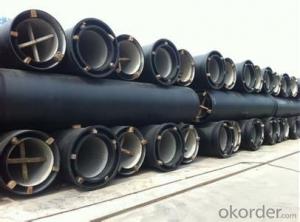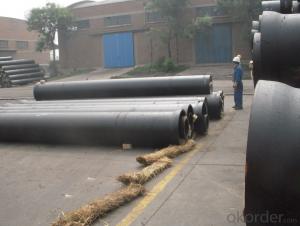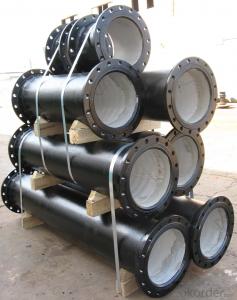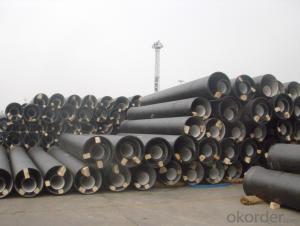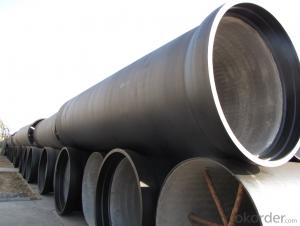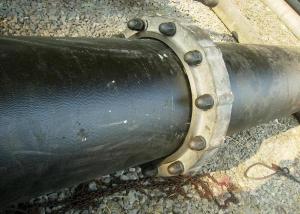DUCTILE IRON PIPES AND PIPE FITTINGS K8 CLASS DN700
- Loading Port:
- Tianjin
- Payment Terms:
- TT OR LC
- Min Order Qty:
- 22 pc
- Supply Capability:
- 3000 pc/month
OKorder Service Pledge
OKorder Financial Service
You Might Also Like
Material : Ductile Cast Iron
Size Range : DN 80mm to DN 2000mm
Unit Effective Length : 6m or 5.7m
Manufacture Standard: ISO 2531:1998/ EN 545:2006/EN 598:2007
Annual capacity : 200,000 tons
Coating Exterior: Zinc 130g/m2 according to ISO 8179-1 and bitumen coating 70 microns.
Cement Interior: Portland Cement/ High Alumina Cement/ Sulphate Resisting Cement Lining according to ISO 4179
Special requirements on external coating and internal lining can be applied
We also provide accessories such as SBR/EPDM rubber gaskets, lubricant paste, pipe caps, PE sleeves, etc.
Additional Parts:
Each pipe is strictly inspected according to related standard to ensure permanently high performance.
Easy Installation at site and service free for life
Long Service Lifespan
Quotation will arrive you within 24hours once we get your inquiry.
We guarantee offering you a competitive price.
A copy of original inspection reports of pipes will be offered after shipment.
Photos of loading process will be sent to the customer after shipment effect.
We will follow-up the delivery progress after shipment effect and update to the customer on weekly basis.
- Q: Can ductile iron pipe be used for both water and sewage applications?
- Ductile iron pipe is versatile and can be used for both water and sewage applications. It is known for its strength, durability, and corrosion resistance, making it suitable for various purposes. With its high tensile strength, it can withstand the pressure and heavy loads associated with water and sewage systems. Its smooth interior surface minimizes friction and enhances flow efficiency, making it perfect for transporting water and sewage. It also has excellent resistance to corrosion and chemical attack, ensuring a long lifespan even in harsh environments. Moreover, ductile iron pipe comes in various sizes and configurations, allowing for customization to meet specific water and sewage requirements. In conclusion, ductile iron pipe is a reliable and adaptable option for water and sewage conveyance.
- Q: How does ductile iron pipe handle temperature changes?
- Ductile iron pipe is renowned for its effective handling of temperature changes. The exceptional properties of ductile iron give it a high resistance to thermal expansion and contraction, enabling it to endure extreme temperature variations without significant distortions or failures. When subjected to temperature changes, ductile iron pipes can expand or contract within specific limits due to their inherent ductility. This flexibility assists in accommodating thermal stresses and preventing pipe cracking or breakage. The material's remarkable tensile strength and elasticity also contribute to its capacity to manage temperature changes without substantial structural harm. Furthermore, ductile iron pipes possess a low coefficient of thermal expansion, meaning they expand and contract at a relatively gradual rate compared to other materials. This characteristic minimizes the potential for stress on pipe joints and reduces the risk of leaks or failures. In addition to its exceptional thermal stability, ductile iron pipe is equipped with a protective lining that further enhances its resistance to temperature changes. Linings such as cement mortar or polyethylene create a barrier between the pipe and the transported fluid, preventing any adverse effects caused by thermal variations on the pipe's inner surface. Overall, ductile iron pipe proves to be a dependable choice for applications where temperature changes are frequent. Its ability to withstand thermal stresses, low coefficient of thermal expansion, and protective linings make it a durable and efficient solution for various infrastructural needs, including water distribution, wastewater management, and industrial applications.
- Q: Is it better to use steel tubes or ductile iron pipes for water supply?
- You need a definite environment to say which kind of pipe is good!1, ductile iron pipe is cheap, corrosion resistance, lack of toughness is poor, not easy to process;
- Q: How do ductile iron pipes handle water velocity?
- Due to their unique mechanical properties, ductile iron pipes are well-suited for managing water velocity. Ductile iron, being a highly durable and strong material, can endure high water velocities without significant damage or deformation. The inherent ductility of the pipe enables it to absorb the energy generated by the flowing water, effectively reducing the risk of pipe failure or bursting. This characteristic makes ductile iron pipes suitable for handling high-pressure water flow, making them an ideal choice in situations where water velocity is a concern. Furthermore, the smooth internal surface of ductile iron pipes promotes efficient water flow and minimizes friction losses. This smoothness reduces resistance encountered by the water as it moves through the pipe, allowing for higher water velocities without compromising the pipe's integrity. Moreover, ductile iron pipes can be manufactured in various sizes and thicknesses, providing customization options based on specific water velocity requirements. This flexibility ensures that ductile iron pipes can effectively manage a wide range of water velocities, from low-flow applications to high-velocity scenarios. In conclusion, ductile iron pipes possess exceptional capabilities when it comes to handling water velocity. Their strength, ductility, and smooth internal surface contribute to their ability to withstand high water velocities without compromising their structural integrity, making them a dependable choice for water distribution systems.
- Q: Do ductile iron pipes require internal linings for potable water?
- No, ductile iron pipes do not require internal linings for potable water.
- Q: Do ductile iron pipes require external coatings or wraps?
- Yes, ductile iron pipes typically require external coatings or wraps for protection against corrosion. While ductile iron is known for its strength and durability, it is still susceptible to corrosion over time when exposed to certain environmental conditions. External coatings or wraps provide an additional layer of protection to the pipes, helping to prolong their lifespan and maintain their structural integrity. These coatings can vary and may include materials such as epoxy, polyethylene, or zinc, which act as a barrier between the pipe surface and corrosive elements in the surrounding environment. Additionally, wraps made of materials like polyethylene or polypropylene can also be used to provide mechanical protection against external factors such as impact or abrasion. Therefore, it is generally recommended to apply external coatings or wraps to ductile iron pipes to enhance their resistance to corrosion and ensure their long-term performance.
- Q: Are there any specific standards or specifications for ductile iron pipes?
- Yes, there are specific standards and specifications for ductile iron pipes. The most commonly used standards for ductile iron pipes are set by the American Water Works Association (AWWA) and the International Organization for Standardization (ISO). The AWWA standard for ductile iron pipes is known as AWWA C151. This standard covers the design, manufacturing, testing, installation, and maintenance requirements for ductile iron pipes used in water and wastewater applications. It specifies the materials, dimensions, and mechanical properties of the pipes, as well as the required coatings and linings. Similarly, the ISO standard for ductile iron pipes is ISO 2531. This standard provides guidelines for the design, manufacturing, testing, and installation of ductile iron pipes for water and wastewater systems. It covers various aspects such as dimensions, mechanical properties, coatings, and linings. In addition to these two widely recognized standards, there may be other regional or national standards specific to certain countries or regions. These standards often align with the AWWA and ISO standards or may have additional requirements specific to local conditions or regulations. Compliance with these standards ensures that ductile iron pipes meet the necessary quality and performance requirements. It also facilitates the interoperability and compatibility of ductile iron pipes across different systems and countries, enabling reliable and efficient water distribution and wastewater management.
- Q: Why is the cast iron tube lined with cement? Under what circumstances are ductile iron pipes lined with cement, and under what circumstances do not have to be lined with cement?
- The cement lining protects the water quality, reduces the head loss and improves the service life of the spheroidal graphite pipe. As long as the water delivery hose is used, the cement lining must be used. There is no lining cement for conveying air.
- Q: Can ductile iron pipes be used for river crossings?
- Yes, ductile iron pipes can be used for river crossings. Ductile iron is a strong and durable material that is capable of withstanding the pressure and stress of being buried and crossed by a river. It is commonly used for various applications, including water and sewage systems, and has been proven to be reliable for river crossings. However, it is important to consider other factors such as the depth of the river, the size and weight of the pipes, and the installation process to ensure the proper design and installation of the ductile iron pipes for river crossings.
- Q: Are ductile iron pipes resistant to frost heave?
- Yes, ductile iron pipes are generally resistant to frost heave due to their strong and flexible nature.
Send your message to us
DUCTILE IRON PIPES AND PIPE FITTINGS K8 CLASS DN700
- Loading Port:
- Tianjin
- Payment Terms:
- TT OR LC
- Min Order Qty:
- 22 pc
- Supply Capability:
- 3000 pc/month
OKorder Service Pledge
OKorder Financial Service
Similar products
Hot products
Hot Searches
Related keywords
